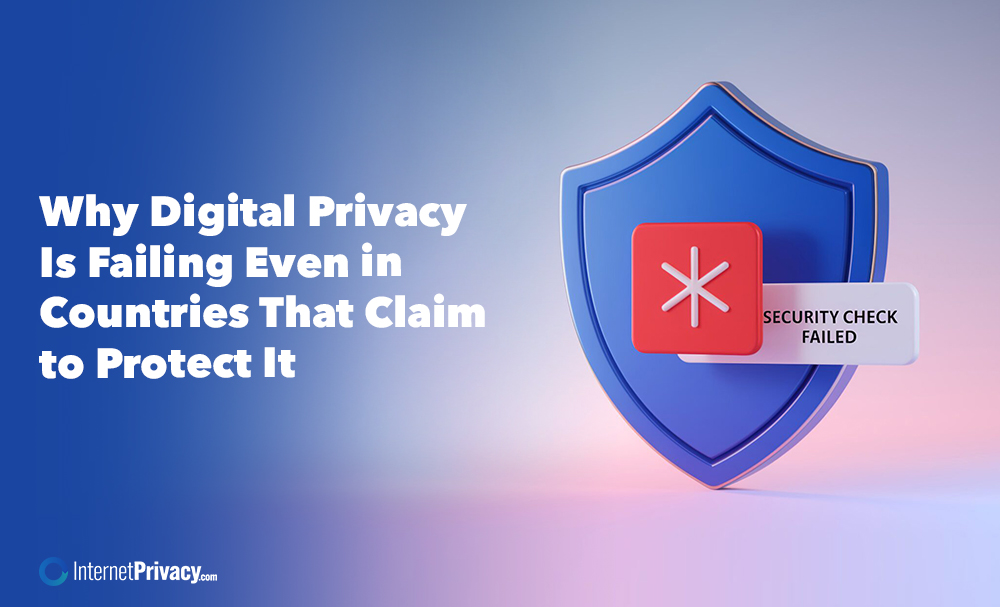Why Digital Privacy Is Failing Even in Countries That Claim to Protect It

Data is currency. But while more countries claim to protect digital privacy, the reality tells a different story. Despite advanced data protection laws and public promises from governments and tech companies, individuals’ digital privacy is routinely compromised. Data breaches, weak enforcement, and widespread surveillance continue to erode trust and put users at risk.
What Is Digital Privacy?
Digital privacy refers to an individual’s ability to control how their personal data is collected, used, and shared online. It encompasses communication privacy (such as messaging apps), online activity tracking, data collection by social media platforms, and protections against unauthorized access to sensitive data, such as health records and financial information. It also involves safeguarding personal information, ensuring that personal data is handled ethically and securely by service providers.
Protecting digital privacy is essential for maintaining security and trust. It empowers users to manage their digital footprint and prevents misuse of personal information. However, privacy violations remain common—even in countries with strong privacy laws—due to systemic issues.
Why Digital Privacy Is So Important
When digital privacy fails, the consequences are significant:
- Identity theft from exposed personal data can lead to financial loss and long-term damage to credit and reputation.
- Phishing attacks and stolen information affect millions annually, undermining confidence in digital services.
- Misuse of private information can cause emotional stress, including harassment or blackmail.
- Loss of trust in service providers and tech companies can discourage digital engagement, hindering innovation and economic growth.
Strong privacy protection enables the safe use of digital services and supports national security by preventing the malicious exploitation of personal data.
The Laws Aren’t Working
Many countries have passed laws designed to protect digital privacy, such as:
- General Data Protection Regulation (GDPR) in the European Union
- California Consumer Privacy Act (CCPA) in the United States
- Health Insurance Portability and Accountability Act (HIPAA) for medical data protection
These laws set standards for data privacy, user rights, and corporate accountability. However, enforcement is often weak, and loopholes remain.
Companies frequently exploit legal gray areas, bury consent in vague privacy policies, or partner with third-party advertisers and data brokers who aggregate and trade personal data. Even when users want to protect their privacy, the tools and transparency often aren’t sufficient.
Why Digital Privacy Keeps Failing
1. Weak Enforcement
Agencies responsible for holding companies accountable often lack funding, authority, or coordination—especially across borders—leading to minimal consequences and continued violations.
2. Widespread Data Collection
Social media platforms, search engines, and apps collect extensive digital data—from location information to browsing behavior—often without users fully realizing how it’s shared with third-party advertisers and data brokers. This undermines individual privacy and creates detailed profiles that can be misused.
3. Frequent Data Breaches
Data breaches expose sensitive information, including financial details and health records. Many companies fail to secure connections or invest adequately in cybersecurity measures like encryption and antivirus software, leaving personal data vulnerable to hackers.
4. Complex Privacy Settings and Dark Patterns
Platforms often design privacy controls to nudge users toward sharing more data, making true opt-outs difficult. This manipulates users’ lack of understanding and reduces control over personal information.
5. Outdated Laws for New Technologies
Legislation struggles to keep pace with advances like artificial intelligence, privacy-enhancing technologies, data brokers, and biometric surveillance, creating exploitable loopholes that erode digital privacy.
How to Strengthen Digital Privacy
To better protect digital privacy, the following are needed:
- Stronger enforcement: Regulatory bodies must have sufficient resources and authority to investigate and penalize violations.
- Transparency from companies: Clear disclosure of what personal data is collected, how it’s used, and with whom it is shared.
- Simplified privacy tools: Easy-to-use settings allowing users to adjust permissions, revoke consent, and delete data without confusion.
- Mandatory security measures: Encryption, secure connections, and strong password policies to protect sensitive information.
- Global cooperation: International collaboration to manage cross-border data transfers and hold global tech firms accountable.
- Adoption of privacy-enhancing technologies: Use of technologies that minimize data collection and protect user anonymity.
What Users Can Do to Protect Themselves
Individuals can take practical steps to improve their online privacy:
- Use strong, unique passwords and enable two-factor authentication.
- Install trusted antivirus software and avoid clicking suspicious links or downloading unknown attachments.
- Limit data shared on social media and public platforms by adjusting privacy settings.
- Use secure connections, such as VPNs, especially on public Wi-Fi.
- Regularly review privacy policies and adapt app and browser settings to control data sharing.
While these actions don’t fix systemic issues, they add layers of protection in today’s digital world.
Final Thoughts
Digital privacy is a cornerstone of freedom and security in the digital age. Yet, even countries that claim to protect it often fall short due to weak enforcement, extensive data collection, and outdated laws.
Moving forward requires clear laws, better enforcement, corporate transparency, and tools that give users real control over their data. Incorporating social perspectives into policymaking can help strike a balance between individual rights and technological and economic realities.
Protecting digital privacy should be a fundamental right, supported by policy, technology, and a commitment to respecting individual privacy across the internet.





